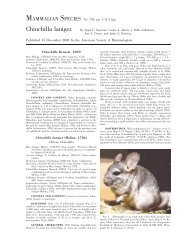Brugia Malayi - Clark Science Center - Smith College
Brugia Malayi - Clark Science Center - Smith College
Brugia Malayi - Clark Science Center - Smith College
Create successful ePaper yourself
Turn your PDF publications into a flip-book with our unique Google optimized e-Paper software.
Possible Seagrass Bed Fragmentation over Two Decades in Carteret<br />
County, NC<br />
Karen Gilbert<br />
Seagrass beds are habitats of great importance as they provide food for many organisms, protect and support larvae, and stabilize<br />
sediment to protect shorelines from erosion. Ferguson and Korfmacher state that alteration of current and salinity patterns, tidal<br />
ranges, water depth, and water quality threaten seagrasses. 1 Seagrass beds require constant monitoring for population change<br />
because they play a vital role in commercial and recreational fisheries. This research compares two study areas near developed<br />
and undeveloped barrier islands in Carteret County, NC, where seagrass bed fragmentation may be occurring. It is possible the<br />
damage from natural and unnatural disturbances, such as hurricanes, sea-level rise, dredging, and boat traffic can indicate where<br />
fragmentation will occur.<br />
Seagrass beds in two areas were mapped using data from three different years (1992, 2006, and 2012) from high quality aerial,<br />
plane-mounted, and satellite image sources. The northern study area is Drum Inlet in Core Sound, which is one of the last inlets<br />
in a North Carolinian barrier island left to change naturally through storms and other events without dredging or other human<br />
interference. The southern study area is near Atlantic Beach in Bogue Sound. This location is surrounded by completely developed<br />
land and is vulnerable to boat disturbance. Both of these mapped areas of seagrass were classified as dense or patchy; classification<br />
was verified through ground-truthing and the changes were quantified using geographical information system technology.<br />
Preliminary analysis suggests that fragmentation is occurring in more areas at Bogue Sound than at the Drum Inlet area. This<br />
is possibly due to the increased human impact in Bogue Sound, such as developed land, dredging, and recreational boat traffic.<br />
Because the Drum Inlet area is remote and undeveloped, the seagrass seems to be fragmenting in fewer areas. Future research<br />
should determine the present amount of natural and unnatural disturbance in Core Sound and Bogue Sound and surrounding<br />
areas and will ask how much these disturbances are actually causing fragmentation. This research will extend into a Special Studies<br />
project in Fall 2012 and will be presented at the Agnes Shedd Andreae Fellowship Symposium at <strong>Smith</strong> <strong>College</strong>. (Supported by<br />
the Agnes Shedd Andreae 1932 Research Internship Fund)<br />
Advisors: Paulette Peckol, Sara Pruss and Don Field, PhD, National Oceanic and<br />
Atmospheric Administration (NOAA), Applied Ecology and Restoration Research Branch,<br />
Beaufort Laboratory, North Carolina<br />
References:<br />
1<br />
Ferguson & Korfmacher, 1998. Remote sensing and GIS analysis of seagrass meadows in North Carolina, USA, 242.<br />
2012<br />
117

















